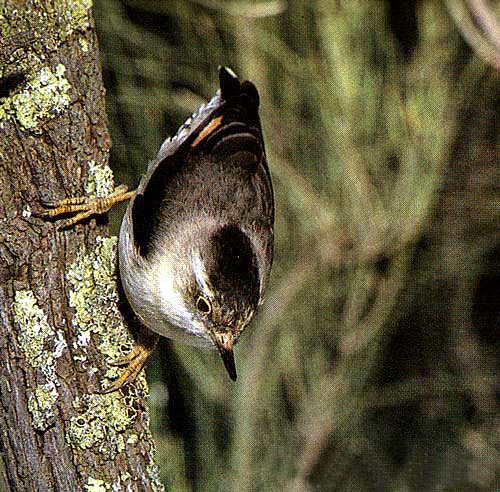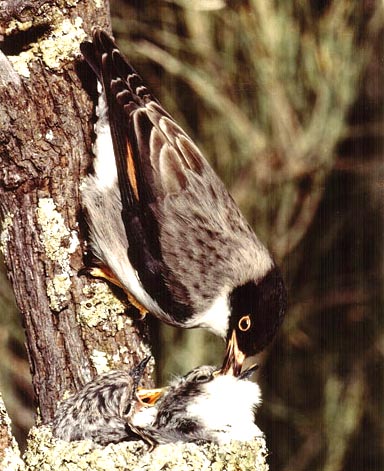 The Sittella is a very small Australasian family composed of just two species:
a New Guinea bird and one variable, sexually dimorphic Australian species,
the Varied Sittella (left and below in beautiful shots
by Hans & Judy Beste). Varied Sittella occurs throughout Australia
wherever there are dry woodlands, avoiding open desert or rain forest.
The Varied Sittella has very different plumage patterns east to west, north
to south. The one shown here is the southern race pileata with a
black cap (male) or black head/white throat (female). Other races have
a gray head (chrysoptera) or a white head (leucoephala) or
have a black cap/white underparts (leucoptera) or black head/streaked
underparts (striatus). Southern birds have a cinnamon wingstripe
(can be seen at base of secondaries in these shots) but northern birds
have a white wingstripe; these wingstripes are best seen in flight. It
has long been known that the groups hybridize where they meet (e.g., Frith
1976) but many checklists considered them separate species through the
1970s (e.g., Cumberland Bird Club 1979). Research then showed that the
races merge into each other where they meet, and that the plumage differences
do not act as isolating mechanisms (Ford 1980, Blakers et al. 1984). Thus
Varied Sittella is a single biological species.
The Sittella is a very small Australasian family composed of just two species:
a New Guinea bird and one variable, sexually dimorphic Australian species,
the Varied Sittella (left and below in beautiful shots
by Hans & Judy Beste). Varied Sittella occurs throughout Australia
wherever there are dry woodlands, avoiding open desert or rain forest.
The Varied Sittella has very different plumage patterns east to west, north
to south. The one shown here is the southern race pileata with a
black cap (male) or black head/white throat (female). Other races have
a gray head (chrysoptera) or a white head (leucoephala) or
have a black cap/white underparts (leucoptera) or black head/streaked
underparts (striatus). Southern birds have a cinnamon wingstripe
(can be seen at base of secondaries in these shots) but northern birds
have a white wingstripe; these wingstripes are best seen in flight. It
has long been known that the groups hybridize where they meet (e.g., Frith
1976) but many checklists considered them separate species through the
1970s (e.g., Cumberland Bird Club 1979). Research then showed that the
races merge into each other where they meet, and that the plumage differences
do not act as isolating mechanisms (Ford 1980, Blakers et al. 1984). Thus
Varied Sittella is a single biological species.
Sittellas will remind non-Australian observers of nuthatches (family Sittidae), although it has long been recognized that they are not closely related. The resemblance to nuthatches recalls the very small species (e.g., Pygmy Nuthatch Sitta pygmaea) in that they tend to occur in small groups (2-12) high in the canopy, moving rapidly from tree to tree in a loose group, excavating insects as they move up and down branches and trunks. Varied Sittellas forage in a wide variety of dry woodlands: eucalyptus, mallee, or acacia scrub. The New Guinea species, Black Sittella Daphoenositta miranda, is quite different in its habitat. It occurs in montane cloud forests of the central ranges of New Guinea, and has been very little studied. |
 Unlike
nuthatches, sittellas weave lovely nests in deep forks. Here (right)
the female feeds young in the nest. They are communal breeders; young from
earlier broods attend the new nest. They also roost communally and sometimes
engage in group-wide allopreening.
Unlike
nuthatches, sittellas weave lovely nests in deep forks. Here (right)
the female feeds young in the nest. They are communal breeders; young from
earlier broods attend the new nest. They also roost communally and sometimes
engage in group-wide allopreening.